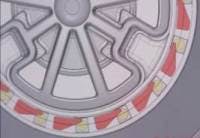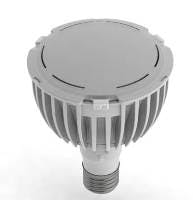Back in April Rambus unveiled new PAR30 and BR30 LED lamps, and now the company has developed a version that can be set to any correlated color temperature (CCT) between 3000K and 5000K. The lamp design includes phosphor-converted white LEDs and a secondary optic with red remote phosphor that can cover all or a part of each LED to provide the CCT adjustment via a mechanical ring.
The PAR and BR Rambus designs have LEDs mounted around the circular area just above the screw base near the bottom of the reflector housing. The LEDs shine up into a light guide in much the same manner used in the company's A19 lamp. But the PAR and BR designs add reflectors and the flat (PR30) or bulged (BR30) diffuser lens.
The adjustable versions add the secondary optic between the LEDs and the light guide. The nearby illustration shows the concept. The wedge-shaped remote phosphor can cover the LED completely, partially, or not at all. By using 5000K LEDs and the red phosphor the design delivers 5000K light when the LEDs are uncovered and 3000K light when the red phosphor completely covers the LEDs.
The nearby photo shows the way the adjustment can be made. The three tabs located around the lamps adjacent to the diffuser can be slid clockwise or counterclockwise to rotate the secondary optic located down near the base of the lamp.
Cost-effective design
The mechanical design offers a very simple approach to tunable CCT. In our Lightfair report in LEDs Magazine, we covered tunable lighting as a major show trend. But most such products include wireless controls and mix red or amber LEDs with white ones and require a multi-channel driver. The Rambus approach is surely less expensive.
The question with the Rambus approach will be how consistently the colors can be set when multiple lamps are used in proximity to one another. Joe Gullo, senior director for product licensing at Rambus, said, "We will be binning the LEDs and phosphor." That will ensure that lamps have the potential for color consistency but still leaves the question of how buyers will set the lamps accurately between the two extremes. Gullo said that Rambus plans to implement several mechanical stops for specific CCTs.
We also questioned the application scenario. Many of the wireless-enabled products at Lightfair were presented for use in dynamic scenarios where the CCT might be changed even over the course of the day. Clearly a mechanical adjustment won't allow such usage scenarios.
Gullo envisions a different usage mode for the Rambus lamps. For example, he said a retail store might only change the CCT when they get new merchandise of a different color. He said commercial office space might change the CCT on a seasonable basis.
Gullo said that Rambus is also contemplating a design that offers some sort of dynamic control but has not decided whether the remote-phosphor mechanical approach is ideal for such a product. In addition to a wireless interface, such a product would need a motor or other actuator to move the secondary optic.
Rambus said the BR30 and PAR30 lamps will be available commercially in the third quarter with the adjustable versions coming late in the quarter. The adjustable version has the potential to reduce the number of SKUs lighting specifiers, retailers, distributors, and others have on hand.







